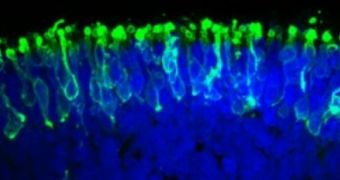A new study published in yesterday's issue of the journal Nature Communications documents the use of human stem cells to piece together a retinal tissue analogue capable of sensing light.
Since picking up on light is the first step towards perceiving complex visual images, scientists argue that the creation of this lab-made retina has high chances to lead to the development of technologies that restore vision.
In order to create their three-dimensional miniature human retina, scientists with the Johns Hopkins University in the United States used genetic engineering to compel adult cells to turn into induced pluripotent stem cells.
As shown by previous investigations, induced pluripotent stem cells have the ability to turn into pretty much all other cell types in the human body, provided that they are placed in an environment that makes it possible for them to do so.
Thus, the induced pluripotent stem cells were then tricked into becoming retinal progenitor cells which, later on, grew to become actual retinal cells and even retinal tissue, the scientists explain in their paper in the journal Nature Communications.
What's interesting is that, despite the fact that they grew inside petri dishes, the retinal cells and retinal tissue took about as much to develop as it would have taken them had they been growing in a human fetus, Newswise informs.
The laboratory-grown miniature human retina owes its ability to detect light to the fact that its makeup includes functioning photoreceptor cells, i.e. rods and cones. As is the case in actual retinas, rods, which enable vision in low light, are predominant.
“We knew that a 3-D cellular structure was necessary if we wanted to reproduce functional characteristics of the retina, but when we began this work, we didn’t think stem cells would be able to build up a retina almost on their own.”
“We have basically created a miniature human retina in a dish that not only has the architectural organization of the retina but also has the ability to sense light,” study leader M. Valeria Canto-Soler, Ph.D., comments on this achievement.
Due to the fact that the faculty of seeing depends on many cells and systems other than the retina and the photoreceptors in it, the scientists who worked on this research project explain that there is plenty of work to be done before anyone could even dream of using lab-grown retinas to restore vision.
“Is our lab retina capable of producing a visual signal that the brain can interpret into an image? Probably not, but this is a good start,” specialist M. Valeria Canto-Soler wishes to stress.

 14 DAY TRIAL //
14 DAY TRIAL //